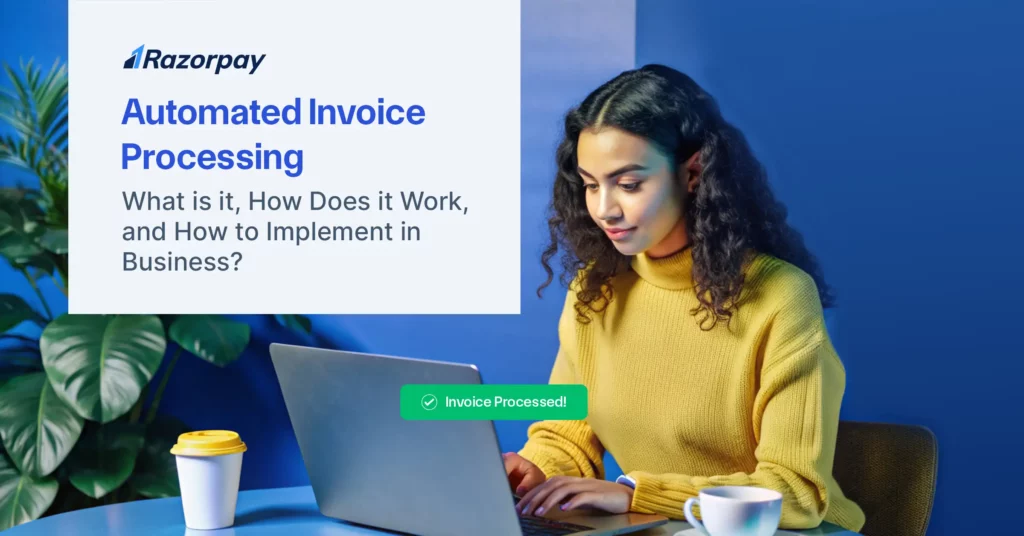Related Read: 15 Types of Invoices: Meaning, Examples and Key Elements
Table of Contents
What Is Automated Invoice Processing?
Automated invoice processing uses software to streamline the invoicing process by automating tasks like data capture, validation, and approval routing. This technology digitizes invoice data, automatically reconciles invoices with purchase orders and receipts, and approves GST tax invoices without manual intervention. By eliminating manual data entry, it boosts productivity, saves time and resources, and provides real-time insights for better cash flow management.
Related Read: What is an Invoice Number and How to Generate One?
Example of Automated Invoice Processing
Imagine a business receives hundreds of invoices every month from various suppliers. In a traditional manual process, an accounts payable clerk would need to open each invoice, enter data into the accounting system, match it with purchase orders, and get approval for payment. This is time-consuming and prone to errors.
With automated invoice processing, the system automatically extracts key information from each invoice, such as supplier details, amounts, and dates. It then matches the invoice with existing purchase orders and receipts in the system. If everything aligns, the invoice is approved for payment without manual intervention. Any discrepancies are flagged for review.
This process speeds up invoice approvals, reduces errors, and ensures that payments are made on time, improving cash flow and supplier relationships.
How Automated Invoice Processing Works? A Step-by-Step Guide
Automated invoice processing systems use advanced technologies to streamline the entire invoicing process, from receipt to payment.
Here’s a breakdown of the typical steps involved:
Step 1. Invoice Capture
- Optical Character Recognition (OCR): Software extracts data from paper or digital invoices using OCR technology.
- Data Extraction: Key data points like invoice number, date, supplier details, item descriptions, quantities, and amounts are automatically extracted.
Step 2. Data Validation
- Accuracy Checks: The system verifies the extracted data for accuracy, ensuring consistency with company standards and regulations.
- Completeness Checks: It ensures that all required fields are filled out correctly.
Step 3. Invoice Matching
- Purchase Order Matching: The system compares invoice details against corresponding purchase orders to verify accuracy.
- Receiving Report Matching: Invoices are matched with receiving reports to ensure that the quantities and items received align with the invoice.
Related Read: Purchase Order Vs. Invoices: What’s the Difference?
Step 4. Coding and Classification
- Automatic Coding: The system assigns appropriate general ledger codes to invoices based on predefined rules or machine learning algorithms.
- Tax Calculation: Taxes are calculated automatically based on the item descriptions and applicable tax rates.
Step 5. Workflow Routing
- Approval Process: Invoices are routed through predefined approval workflows based on their value, department, or other criteria.
- Notifications: Approvers are notified via email or other channels to review and approve or reject invoices.
Step 6. Payment Processing
- Payment Authorization: Approved invoices are sent for payment authorization.
- Payment Initiation: The system can automatically generate payment files in various formats (e.g., ACH, wire transfer) and send them to the bank.
Step 7. Posting and Reconciliation
- Posting: Approved and paid invoices are posted to the general ledger.
- Reconciliation: The system reconciles invoice payments against bank statements to ensure accuracy.
Step 8. Reporting and Analytics
- Detailed Reports: The system generates various reports, such as vendor performance, payment trends, and invoice processing times.
- Analytics: Advanced analytics can provide insights into areas for improvement and identify potential fraud risks.
Benefits of Automated Invoice Processing for Businesses
1. Reduction in cost
Automated systems reduce the manual effort and resources required to process invoices, resulting in significant cost savings of up to 80%.
2. Cost-effectiveness and Better Cash Flow Management
By automating tasks like matching, data entry, and approval workflows, invoice processing times are accelerated, enabling faster payments and better cash flow management for businesses.
3. Reduction in Errors and Improved Accuracy
Advanced technologies like AI and machine learning minimize human errors, validate invoice data, and detect discrepancies, ensuring processing accuracy.
4. Access to Data in Real-time
Automated systems provide real-time visibility into invoice status, payment schedules, and financial data, enabling better tracking and proactive decision-making.
5. Less Paperwork and and the Creation of an Audit Trail
Automated invoice processing reduces paper usage and maintains detailed audit trails, simplifying compliance and audits.
5. Enhancements to Vendor Relationships and System Integrations
Seamless integration with accounting software, ERP systems, and cash management tools streamlines data management and improves vendor relationships through faster, more accurate payments.
6. Speedier Processing of Invoices
Automated workflows and approval processes eliminate bottlenecks, ensuring faster invoice processing and payment.
7. Insights into Data Analytics
Machine learning algorithms can forecast invoice amounts, recommend optimal payment dates to capture discounts, and provide valuable insights for budgeting and forecasting.
8. Increased Productivity
By automating manual tasks and streamlining workflows, automated invoice processing frees up employees to focus on more strategic tasks, boosting overall productivity.
9. Enhanced Security and Compliance
Automated systems enforce regulatory compliances and internal controls, mitigating risks and maintaining accountability in financial operations.
10. Ability to Scale Business Operations Without the Need for Additional Hiring
As business volumes grow, automatic invoicing can handle increased invoice volumes without needing additional headcount, enabling scalability.
How to Implement Automated Invoice Processing for your Business?
STEP 1: Assess Current Process and Define Goals
- Evaluate your current invoice processing procedures to identify bottlenecks and inefficiencies.
- Clearly define your objectives for automation, such as reducing processing time, minimizing errors, and improving cash flow.
STEP 2: Evaluate Infrastructure and Training Needs
- Assess your company’s hardware and software infrastructure to determine compatibility with automated solutions.
- Identify training requirements for employees to ensure a smooth transition to the new system.
STEP 3: Select the Right Automation Solution
- Research and compare different automated invoice processing systems based on your budget, business size, and specific needs.
- Choose a system that offers essential features like data capture, reporting, scalability, and user-friendly interface.
STEP 4: Integrate with Existing Systems
- Seamlessly integrate the chosen automation solution with your ERP system and other relevant software to optimize data flow.
- Ensure accurate data transfer and minimize manual data entry.
STEP 5: Define Roles and Responsibilities
- Clearly outline the roles and responsibilities of team members involved in the invoice processing workflow.
- Establish effective communication channels to facilitate collaboration.
STEP 6: Pilot Test and Implement
- Conduct a pilot test with a selected group of users to evaluate the system’s performance and identify potential issues.
- Refine the system based on pilot test results and implement the solution across the organization.
Must Read: How to send an Invoice?
Challenges in Manual Invoice Processing
1. Disappearing Invoices
Invoices can be easily misplaced in the swirl of paperwork, resulting in payment delays and hindered vendor relationships. The lack of a consistent tracking mechanism worsens the issue.
2. Data Entry Errors
Manual data input is vulnerable to human errors causing payment delays and financial inconsistencies, requiring extensive time-consuming corrections.
3. Slow Invoice Processing
Manual handling of invoices frequently results in lengthy processing delays owing to various processes and approvals. This inefficiency can jeopardize cash flow and strain supplier relationships.
4. Duplicate Invoices
Manual processes increase the likelihood of multiple invoices being processed, either due to human error or miscommunication. This might result in avoidable expenses and accounting issues.
5. Discrepancies and Exceptions
Matching invoices with purchase orders can be difficult, resulting in time-consuming errors. These exclusions might wear down the whole payment procedure.
6. Delay in Approval Processes
Invoice approval might be significantly delayed owing to manual document routing and participation of several stakeholders. This could result in late payments and missing discounts.
7. Risk of Fraud
Manual invoice processing is prone to fraud because it lacks the strong checks and balances provided by automated systems. This vulnerability can lead to financial losses and reputational damage for any business.
8. Double Payment
Manual processes increase the chance of multiple payments since invoices might be ignored or handled erroneously. This can lead to financial pressure and disrupt vendor relationships.
Related Read: Reasons for Online Payment Failure & How to Handle Them in 2025?
How to Choose the Best Automated Invoice Processing Software for Your Business
Choosing the right automated invoice processing software can transform your business’s efficiency and productivity. Here’s a guide to help you make the best choice:
1. Assess Your Business Needs:
- Determine the volume of invoices you process and the complexity of your workflows.
- Identify if you need features like multi-currency support or integration with specific ERP systems.
2. Ease of Integration:
- Ensure the software easily integrates with your existing accounting, ERP, and financial systems.
- A seamless integration process will save you time and reduce operational disruptions.
3. Automation Features:
- Look for key features like automatic data capture, invoice matching, and approval workflows.
- Ensure the software automates tax calculations, especially for GST and VAT compliance.
4. User-Friendliness:
The software should be easy to navigate for your team. Look for a user-friendly interface that requires minimal training.
5. Scalability:
- As your business grows, you’ll need software that can scale with your needs. Choose a platform that accommodates future growth in terms of transaction volume and functionality.
6. Security and Compliance:
- The software should comply with relevant tax laws and financial regulations.
- Ensure the platform uses encryption and other security measures to protect sensitive invoice data.
7. Customer Support:
- Reliable customer support is essential, especially when dealing with financial transactions. Choose a provider that offers 24/7 support and troubleshooting assistance.
8. Pricing:
- While pricing is important, don’t base your decision solely on cost. Weigh the value of features and long-term benefits over upfront costs.
Why Should You Choose Razorpay To Automate Invoice Processing?
Here are the major advantages of using Razorpay to automate your invoice processing:
- Eliminates manual data entry: Intelligent OCR captures invoice details automatically.
- Saves time and effort: Streamlines the invoice processing workflow.
- Prevents errors: Advanced deduplication algorithm avoids duplicate payments.
- Easy invoice upload: Supports multiple methods including email, vendor portals, and accounting software integration.
- Automates TDS calculations: Accurately calculates and deducts TDS based on vendor categories.
- Enhances efficiency: Smooth reconciliation between automated receipts and accounting software.
Create your Invoices with Razorpay Invoicing Software
Conclusion
Automated invoice processing is revolutionizing accounts payable by significantly improving accuracy and efficiency. By leveraging technology, businesses can streamline the entire invoice lifecycle. As Indian companies increasingly recognize the value of precision and speed in financial management, the adoption of automated solutions is on the rise. With a projected 80% of invoices processed electronically by the end of 2024, automation is undeniably reshaping modern business operations.
Frequently Asked Questions
1. What is the difference between manual invoice and automated invoice?
Manual invoice processing is slow and prone to errors. Automation speeds up the process, reduces errors, and enables electronic invoicing and real-time tracking.
2. How secure are automated invoicing systems?
Automated invoicing systems prioritize data security with advanced encryption and strict compliance. Multi-factor authentication safeguards against unauthorized access, ensuring the protection of financial transactions.
3. Can automated invoicing save costs for businesses?
Automated invoicing systems have revolutionized the way businesses handle their financial operations. By automating various tasks, these systems offer significant benefits in terms of efficiency, accuracy, and cost-effectiveness.
4. Is automated invoicing suitable for small businesses?
Automated invoicing empowers small businesses by streamlining processes, reducing errors, and freeing up resources, enabling them to focus on growth.
5. How much does automated invoice processing cost?
Razorpay offers free automated invoice software with transaction fees of 2% (domestic) and 3% (international) + GST. There are no setup fees, making it a cost-effective solution with a free trial. Automation can significantly reduce long-term costs by minimizing human labor and errors.


